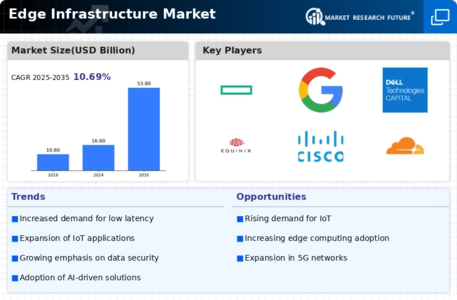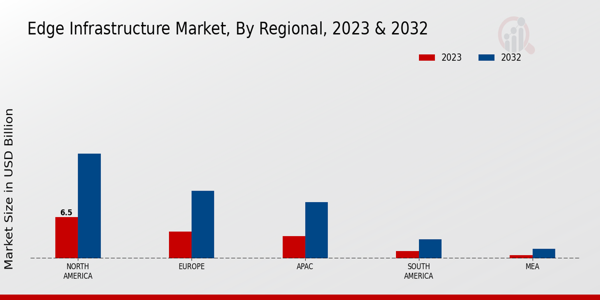Expansion of IoT Devices
The Global Edge Infrastructure Market Industry is significantly influenced by the rapid expansion of Internet of Things (IoT) devices. As more devices connect to the internet, the volume of data generated increases exponentially, necessitating localized processing to manage this influx. Edge infrastructure facilitates this by enabling data processing closer to the source, thus improving response times and reducing bandwidth costs. The anticipated growth in the number of connected devices is expected to drive the market's value, with projections indicating a compound annual growth rate of 11.27% from 2025 to 2035, underscoring the critical role of edge solutions in managing IoT ecosystems.
Emergence of Smart Cities
The Global Edge Infrastructure Market Industry is significantly impacted by the emergence of smart cities, which leverage advanced technologies to improve urban living. Edge infrastructure plays a crucial role in supporting the vast array of sensors and devices deployed in smart city initiatives, facilitating real-time data processing and analysis. This integration enhances traffic management, energy efficiency, and public safety, among other aspects. As cities worldwide invest in smart technologies, the demand for edge solutions is expected to rise, further propelling the market's growth and aligning with global sustainability goals.
Market Growth Projections
The Global Edge Infrastructure Market Industry is projected to experience substantial growth, with estimates indicating a market size of 16.6 USD Billion in 2024 and a remarkable increase to 53.8 USD Billion by 2035. This growth trajectory suggests a compound annual growth rate of 11.27% from 2025 to 2035, reflecting the increasing reliance on edge computing solutions across various sectors. The expansion is driven by factors such as the rise of IoT devices, the adoption of 5G technology, and the growing emphasis on data privacy and security, all of which contribute to the market's dynamic evolution.
Increased Adoption of 5G Technology
The Global Edge Infrastructure Market Industry is poised for growth due to the increased adoption of 5G technology. The deployment of 5G networks enhances connectivity and supports a higher density of devices, which in turn drives the need for edge computing solutions. With 5G's ability to provide faster data transfer rates and lower latency, businesses are likely to invest in edge infrastructure to leverage these capabilities. This shift is expected to contribute to the market's expansion, as organizations seek to optimize their operations and improve service delivery in a highly competitive landscape.
Rising Demand for Low Latency Services
The Global Edge Infrastructure Market Industry experiences a notable surge in demand for low latency services, driven by the proliferation of real-time applications such as online gaming, video conferencing, and autonomous vehicles. As businesses increasingly rely on instantaneous data processing, edge infrastructure becomes essential for minimizing latency. In 2024, the market is projected to reach 16.6 USD Billion, reflecting the growing necessity for efficient data handling. This trend is expected to continue, with the market potentially expanding to 53.8 USD Billion by 2035, indicating a robust growth trajectory fueled by the need for enhanced user experiences.
Growing Focus on Data Privacy and Security
The Global Edge Infrastructure Market Industry is increasingly shaped by the growing focus on data privacy and security. As organizations face heightened scrutiny regarding data protection, edge computing offers a viable solution by enabling data processing at the source, thereby minimizing the risk of data breaches during transmission. This localized approach not only enhances security but also complies with various regulatory requirements. The emphasis on safeguarding sensitive information is likely to drive investments in edge infrastructure, as businesses recognize the importance of maintaining customer trust and adhering to legal standards.















